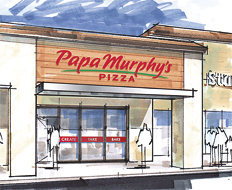The history books detailing the recent Great Recession will include plenty of obvious chapters: the subprime mortgage crisis, Wall Street bailouts, housing bubbles, and skyrocketing unemployment. But those volumes might miss a less visible element of the economic collapse: the crippling credit market that wreaked havoc by bringing business growth to a near standstill.
As the American economy went down the tube, so did banks’ willingness to lend capital for new ventures. Those hoping to open new restaurants or invest in existing units were forced to find new funding means. Even the most credit-worthy applicants struggled to find loan approval.
The financial landscape has since eased up. Lower unemployment levels and stronger consumer confidence have encouraged banks to start lending again. But with the wounds of the economic collapse still fresh, banks also find themselves under tougher public scrutiny and heightened regulations, and they’re only offering big bucks to the surest bets.
“If you’re an established operator, it’s pretty simple to get financing,” says Dennis Monroe, a veteran in business law and corporate financing and chairman of Monroe Moxness Berg PA, a law firm specializing in multiunit franchise finance, mergers and acquisitions, and taxation. “What gets trickier is when you move down the food chain to concepts that are less known, ones that are more regional concepts or ones that are start-ups.”
Most restaurant lending is still coming from traditional community banks, as well as Small Business Administration–backed loans, Monroe says. There are, however, new avenues for funding that have sprouted from the ruins of the Great Recession; alternative funding sources, which often offer smaller loans at higher rates, have exploded in number and prominence. Operators are also testing new financing strategies to ensure sustainable growth in the coming years.
Indeed, upstart quick serves and experienced operators alike have a different financing tool set to review as they look for new ways to grow their business post-recession.
BoeFly, an online lending network that includes more than 3,500 lenders, is one new model for operators looking to borrow, allowing them to easily shop around for the best rates and terms. Co-president Mike Rozman says the most successful borrowers today are those who are aggressive about selling themselves and their businesses, and who diligently prepare financial documents, bank statements, and performance records for a brand.
“Very simply, it’s the borrower’s job to make sure that their banker feels comfortable making that loan,” Rozman says.
Experts say the franchisor should also play an active role in the financing process by selling the brand to lenders, vetting potential finance partners, and connecting franchisee hopefuls with lending sources. Strong vetting at headquarters means that those who ultimately receive corporate approval will have little trouble finding financing, says Jim Sullivan, senior vice president of domestic franchise development for CKE, parent company of Hardee’s and Carl’s Jr.
“So we know [franchisees] have adequate capital to build restaurants going in,” Sullivan says. “Those that we approve to come build restaurants should not experience a problem developing projects.” He adds that more conventional lenders are stepping back into the market, but more alternative means of growth, like build-to-suit opportunities—in which developers or landowners build a store to the operator’s specs and then the operator leases it from them—continue to emerge.
Though it undoubtedly slowed business growth, the uncertainty in the long-term debt market has actually boosted the popularity of alternative lending. Short-term lenders offer an easier way in for cash-strapped operators who need quick access to working capital, although the ultimate payback is high.
These loans are often based on a business’s cash flow, not individual credit scores. That structure allows alternative lenders to meet a need that traditional banks just aren’t equipped to handle, says Andrea Gellert, senior vice president of marketing at On Deck, which has provided more than $10 million in small loans to quick-service concepts.
She says instant approval of $5,000–$150,000 loans helps restaurants invest in equipment or facilities, filling a void in the financing market.
“We do hear from [quick serves] who are franchisees that oftentimes it’s not on the radar screen of franchisors,” Gellert says. “Often, they’re not aware of the need that their franchisees have [for short-term capital].”
Two or three years ago, restaurants sought this kind of short-term capital mostly to put out fires—replace a broken oven, cover a payroll period, make an upcoming tax payment. But lenders say most operators have moved beyond Band-Aids. They’re now looking to expand restaurants, renovate, upgrade fixtures, or add a porch or patio.
“We’re seeing a shift in the needs. The guys who have survived the past few years now have a lot of opportunity in the marketplace,” says Scott Griest, CEO of American Finance Solutions.
Instead of monthly or quarterly bills, American Finance Solutions automatically collects a set percentage of each credit card transaction at the borrower’s business. Repayments like this are easier to stomach, Griest says, because the cash is drawn before it ever hits a restaurant’s coffers.
In some cases, short-term loans can carry the costs of new growth. Capital Access Network has funded new-development costs with access to capital by leveraging an operator’s existing store volume. Depending on cash flow, the company is able to provide businesses with access to up to $150,000 per unit, meaning a 10-unit owner could access as much as $1.5 million and remit from credit card receipts at all 10 stores.
“I think in general, if somebody’s looking for $1 million to buy their first restaurant, that is a different universe from what we do,” says Diane Naczi, senior vice president for Capital Access Network. “But we have helped people who have 10 units already and they are using those units to fund the next unit.”
While many are fearful of predatory lending, Naczi says, loans like those from Capital Access Network and merchant cash advances are not like the cash advances and payday loan shops that consumers can find on the streets because businesses know their final price of repayment up front.
[pagebreak]
In addition to short-term capital, restaurant operators can find an array of other creative options to fund new projects.
The crowdfunding site Foodstart.com recently launched to help restaurant and food-truck owners raise small amounts from friends and family online. Instead of a cash return, backers receive perks like free dessert, discounts, and workshops. In addition, in April, Business Financial Services announced an $82 million line of credit that it and Wells Fargo Capital Finance made available to small and medium-sized businesses to help fill the void for businesses whose credit needs remain unaddressed by traditional banks. And private equity firms are showing an interest in playing a part in restaurant growth.
Atlanta-based BIP Opportunities Fund LP, for example, bought a minority interest in the Pan Asian fast-casual chain Tin Drum AsiaCafé to get its aggressive growth plan going. Other quick serves, like Bojangles’, have been wholly purchased by private equity firms.
Jack Slye, principal at the Philadelphia-based private equity firm LLR Partners, says restaurant operators are growing increasingly interested in private equity groups as an alternative to slow and steady growth or franchising models because it’s much easier to grow quickly with a huge infusion of cash.
LLR has been kicking the tires of emerging restaurant concepts, especially mid-level quick serves and fast casuals. The company hasn’t bought into a concept yet, but Slye says it’s only a matter of time before it invests in the restaurant realm for the first time. Given unit economics and the strength of the segment, he says, quick-serve and fast-casual concepts remain a solid investment.
“We found a bunch of great companies we like,” he says. “We think there are a lot of companies out there that are very attractive.”
For all the new ways to drum up cash, restaurant operators say it’s still the small and regional banks that shoulder most of the growth in the quick-service segment. But a few years ago, those institutions weren’t lending at all, says Mike Brown, a Jersey Mike’s Subs franchisee and area director in California.
“We opened five stores in three years with no traditional financing,” he says. “We managed to build those restaurants with duct tape and chewing gum.”
A 35-year veteran of the quick-service franchise business, Brown borrowed from friends and credit cards and used his own cash to open stores from 2009 to 2012. Things have improved dramatically since, and he now gets multiple loan offers when looking to open new stores.
In fact, the whole company is having better luck finding financing.
“That’s primarily because we’re growing with existing franchisees and new franchisees that are coming in from other brands that already have a track record and assets,” says Jersey Mike’s president Hoyt Jones.
With a tougher lending market, Small Business Administration loans are also helping to boost quick-serve growth. Backing from the SBA offers much-desired assurance to other lenders. Last year, the SBA backed about $2.3 billion in restaurant loans—nearly $500 million more than in 2010.
“Banks are looking for a guarantee,” says Kevin King, Papa Murphy’s chief development officer.
King says lenders are requiring more documentation and are scrutinizing applicants more closely since the credit crisis. It may not be that banks have changed their rules on lending, he says, but that they are merely enforcing the rules they already had on the books.
Even at its most severe, the recession didn’t entirely halt Papa Murphy’s growth. The brand plans to open 125 new stores in 2013. “It just slowed it down because of the amount of time it took to get financing,” King says. “It takes some getting used to what the new process is going to be.”
Similarly, it seems that more brands are adapting to the new normal. Growth in limited-service chains stagnated in 2010 and 2011, but in 2012, brands in Technomic’s Top 500 Chain Restaurants added more than 3,500 units, a 2.2 percent increase over 2011.
“We have seen a large uptick in the last year or so in regards to new small-business requests for [quick-service] companies,” says Doug Cullinan, senior vice president of Cornerstone Bank’s small-business capital group. “I think that’s just a function of more people being willing to take the plunge into small business.”
Since the credit crash, Cullinan says, Cornerstone Bank has relied more on SBA loans.
“We’re not really looking at applicants differently. We’re just focusing more on the SBA process,” he says. “The bank gets some guarantee and some comfort on the loan. But more importantly, the borrowers get some favorable terms.”
He says a brand’s history also plays a central role in the approval process. Without existing units and experience to lean on, he says, applicants should have independent wealth and a strong credit rating if they expect to find financing.
Some business rookies, though, are still finding a way in. For example, newcomers are buying back into the Bennigan’s brand, which filed for Chapter 7 bankruptcy in 2008. That move shuttered dozens of corporate restaurants.
CEO Paul Mangiamele says the 85-unit company, which was previously all casual but which recently debuted a fast-casual model, is now opening about a store a month, some in the company’s old locations and some in the remnants of other closed chain restaurants. He says new franchisees are finding resourceful ways for funding growth, like dipping into retirement accounts or taking out home equity lines of credit.
But the financial market is indeed getting easier to navigate, Mangiamele says; potential investors and lenders have started approaching the company about financing growth.
“The climate has been very difficult the last several years,” he says. “This is the first time that I’ve seen that glimmer of hope.”







